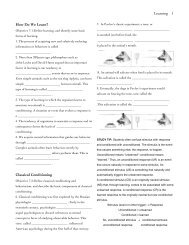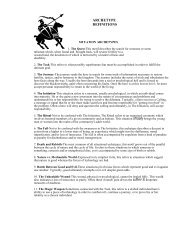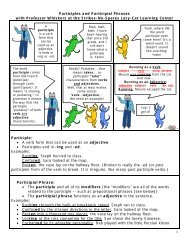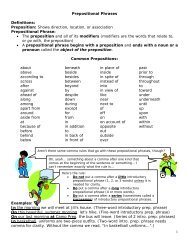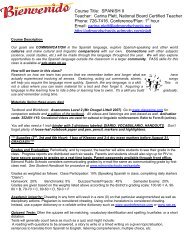1 SEE AGGRESSION ... DO AGGRESSION! - Edmond Public Schools
1 SEE AGGRESSION ... DO AGGRESSION! - Edmond Public Schools
1 SEE AGGRESSION ... DO AGGRESSION! - Edmond Public Schools
Create successful ePaper yourself
Turn your PDF publications into a flip-book with our unique Google optimized e-Paper software.
4<br />
The children who were exposed to the violent models tended to imitate the exact violent behaviors they<br />
observed. There were an average of 38.2 instances of imitative physical aggression for each of the male subjects,<br />
and 12.7 for the female subjects who had been exposed to the aggressive models. Additionally, the models'<br />
verbally aggressive behaviors were imitated an average of 17 times by the boys and 15.7 times by the girls. These<br />
specific acts of physical and verbal aggression were virtually never observed in the subjects exposed to the<br />
nonaggressive models or in the control subjects who were not exposed to any model.<br />
As you will recall, Bandura and his associates predicted that nonaggressive models would have a<br />
violence-inhibiting effect on the children. In order for this hypothesis to be supported, the results should show<br />
that the subjects in the nonaggressive conditions averaged significantly fewer instances of violence than those in<br />
the no-model control group. In Table 1, if you compare the nonaggressive model columns with the control group<br />
averages, you'll see that the findings were mixed. For example, boys and girls who observed the nonaggressive<br />
male exhibited far less nonimitative mallet aggression than controls, but boys who observed the nonaggressive<br />
female aggressed more with the mallet than did the boys in the control group. As the authors readily admit, these<br />
results were so inconsistent in relation to the aggression-inhibiting effect of nonaggressive models that they were<br />
inconclusive.<br />
The predicted gender differences, however, were strongly supported by the data in Table 1. Clearly,<br />
boys' violent behavior was influenced more by the aggressive male model than by the aggressive female model.<br />
The average total number of aggressive behaviors by boys was 104 when they had observed a male aggressive<br />
model, compared with 48.4 when a female model had been observed. Girls, on the other hand, while their scores<br />
were less consistent, averaged 57.7 violent behaviors in the aggressive female model condition, compared with<br />
36.3 when they observed the male model. The authors point out that in same-sex aggressive conditions, girls<br />
were more likely to imitate verbal aggression while boys were more inclined to imitate physical violence.<br />
Finally, boys were significantly more physically aggressive than girls in nearly all the conditions. If all<br />
the instances of aggression in Table 1 are tallied, there were 270 violent acts by the boys, compared with 128 by<br />
the girls.<br />
DISCUSSION<br />
Bandura, Ross, and Ross claimed that they had demonstrated how specific behaviors—in this case, violent<br />
ones—could be learned through the process of observation and imitation without any reinforcement provided to<br />
either the models or the observers. They concluded that children's observation of adults engaging in these<br />
behaviors sends a message to the child that this form of violence is permissible, thus weakening the child's<br />
inhibitions against aggression. The consequence of this observed violence, they contended, is an increased<br />
probability that a child will respond to future frustrations with aggressive behavior.<br />
The researchers also addressed the issue of why the influence of the male aggressive model on the boys<br />
was so much stronger than the female aggressive model was on the girls. They explained that in our culture, as in<br />
most, aggression is seen as more typical of males than females. In other words, it is a masculine-typed behavior.<br />
So, a man's modeling of aggression carried with it the weight of social acceptability and was, therefore, more<br />
powerful in its ability to influence the observer.<br />
SUBSEQUENT RESEARCH<br />
At the time this experiment was conducted, the researchers probably had no idea how influential it would<br />
become. By the early 1960s, television had grown into a powerful force in American culture and consumers were<br />
becoming concerned about the effect of televised violence on children. This has been and continues to be hotly<br />
debated. In the past 30 years, there have been no fewer than three congressional hearings on the subject of<br />
television violence, and the work of Bandura and other psychologists has been included in these investigations.<br />
These same three researchers conducted a follow-up study two years later that was intended to examine<br />
the power of aggressive models who are on film, or who are not even real people. Using a similar experimental<br />
method involving aggression toward a Bobo doll, Bandura, Ross, and Ross designed an experiment to compare<br />
the influence of a live adult model with the same model on film and to a cartoon version of the same aggressive<br />
modeling. The results demonstrated that the live adult model had a stronger influence than the filmed adult, who,<br />
in turn, was more influential than the cartoon. However, all three forms of aggressive models produced<br />
significantly more violent behaviors in the children than was observed in children exposed to nonaggressive<br />
models or control subjects (Bandura, Ross, & Ross, 1963).



